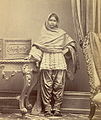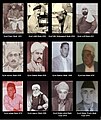PAKISTAN NATIONAL DRESSES
13:06:00Pakistani national dress
The salwar kameez is the national dress of Pakistan[1][2] and is worn by men and women in all four provinces Punjab, Sindh, Baluchistan and Khyber Pakhtunkhwa in the country and in Azad Kashmir. Salwar refers to loose trousers and kameez refers to shirts. Since 1982, all officials working in the secretariat are required to wear the national dress.[3]
Each province has its own style of wearing the salwar kameez such as Sindhi shalwar kameez, Punjabi shalwar[4] kameez, Khyber Pakhtunkhwa shalwar kameez and Balochi shalwar kameez. Pakistanis wear clothes ranging from exquisite colours and designs to various types of fabric such as silk, chiffon, cotton, etc.[5]
Men's clothing
Men wear salwar kameez, kurta, Pakistani Waistcoat, achkan and sherwani, churidar or pajama. In 1971 a young 16yr old "Zain Jeewanjee" introduced "SHAFT CLOTHING" and designed ready to wear Shalwar Kameez for Karachi's elite, this started the trend in Pakistan for ready made clothing for men, closely followed by TJ's and others. Other items of clothing include the jama and the angarkha. Headgear includes the Jinnah Cap also called Karakul, Fez also called Rumi Topi and Taqiyah (cap). Khussa is popular foot wear. Other items include traditional shawls made of Pashmina or other warm materials especially in the Northern regions of the country.
Regional clothing
Balochistan[edit]
A Baloch wears a long jama (robe) like a smock-frock down to the heels, loose shalwar, a long chadar or scarf, a pagri of cotton cloth, and mostly shoes that nanow at the toe.[6] The material is thick cloth with very wide shalwar to protect against the hot wind of the dry Sulaiman Range and Kharan Desert.
Sindh
Sindhi people wear a version of the shalwar called a suthan[7][8] with a kameez called cholo.[9] Other traditional clothing includes the Sindhi cap and Ajrak of beautiful designs which are made locally. Men also traditionally wear the dhoti and the long angerkho.
Punjab
Punjabi men wear the straight cut Punjabi shalwar kameez, kurta and shalwar, dhoti, lungi[11] or tehmat[12][13] and kurta. Other Punjabi shalwar styles include the Pothohari shalwar,[14] Multani shalwar, Dhoti shalwar and the Bahawalpuri shalwar which is very wide and baggy[15] with many folds. Turban of a thin cloth is also worn especially in rural areas of Punjab where it is called pagri. Footwear include the khussa.
Khyber Pakhtunkhwa
In Pashtun dress, people wear traditional Peshawari chappal[16] as footwear. The traditional male Pashtun dress includes the Khet partug,[17] Peshawari shalwar and the Perahan wa tunban. Males usually wear kufi, Peshawari cap, turban, sindhi cap or pakul as traditional headgear.
Azad Kashmir[edit]
The clothing of Azad Kashmir includes various styles of the shalwar kameez.
Women's clothing
Shalwar kameez
Pakistani women wear the shalwar kameez which is worn in different styles, colors and designs which can be decorated with different styles and designs of embroidery. The kameez can be of varying sleeve length, shirt length, necklines. The drawers can be the straight-cut shalwar, patiala salwar, churidar, cigarette pajama, tulip trouser or simple trouser.
Dupatta
The Dupatta is an essential part of shalwar kameez ensemble and is considered a symbol of a woman's respect. Essentially, the dupatta is often treated as an accessory in current urban fashion. Most of women who carry it now wear it just as a decorative accessory; wrapping around the neck or hanging down the shoulder. Dupatta is also used by women when entering a mosque, dargah, church, gurdwara or mandir, it is the habit in the Indian subcontinent for women to cover their head with a dupatta. It is also widely worn by women in wedding and other parties out of choice. On such occasions it is wrapped round the waist, neck or just put on a shoulder. It is used with different embroidery designs of Kamdani and Gota.
Other traditional dresses
Pakistani women have a variety of traditional dresses in addition to the shalwar kameez but they mostly wear them on special occasions such as on weddings, engagements, mehndiand other traditional ceremonies.
The dresses include the ghagra choli and saris which are very popular and its each design and color seems unique from the other e.g. lehenga style sari. The lehenga is another popular dress which resembles a skirt but is traditional dress. The gharara and sharara are two similar dresses which are often worn on ceremonial occasions. Farshi Pajama is an old traditional dress which is worn occasionally. Laacha is worn in the Punjab,[18] the lower part of which resembles the dhoti.
Regional clothing
Balochistan
A typical dress of a Baloch woman consists of a long frock and shalwar with a headscarf.[19] Balochi women wear heavy embroided shalwar kameez and dupatta with the embroidery utilising Shisha work.[20]
Sindh
In addition to wearing the suthan and cholo, Sindhi women wear the lehenga and choli known as the gaji which is a pullover shirt worn in the mountain areas of Sindh. The gaji is composed of small, square panels, embroidered on silk and sequins. The neck line of the gaji is cut high, and round on one side, with a slit opening extending the other. Unmarried girls wear the opening to the back and married women, to the front.[21] Sindhi clothing displays embroidery using mirrors.[20]
Punjab
Punjabi women wear the straight cut Punjabi shalwar kameez,[22] originally a purely Punjabi dress, which is most frequently worn, and is the uniform of the women's National Guard of Pakistan, the women's naval reserve, the Pakistan Girl Guides Association, Pakistani nurses[23] and forms part of national dress.[24] Punjabi women, in villages, also wear the Pothohari shalwar, the Patiala shalwar, the laacha (tehmat),[25] kurti,[26] ghagra,[27] lehenga and phulkari.
Khyber Pakhtunkhwa
Women of the kalash region wear long dresses colourfully embroidered. In other areas, women wear the shalwar kameez[28] known as the firaq partug which is also worn in neighbouring Afghanistan.
Kashmir
Religious clothing
By women's religious clothing we mean the dressing in which they try to cover all their body parts except face and hands while going outside from their home.Mostly women fully or partially cover their heads with Dupatta or Chadar in outdoors but religious women prefer to wear Scarf, Burqa or Hijab and wear lose, long full and half sleeve shirts. Religious men wear long tunics.





































































.jpg)
4 comments
This comment has been removed by the author.
ReplyDeleteBy women's religious clothing we mean the dressing in which they try to cover all their body parts except face and hands while going outside from their home.
ReplyDeletefire alarm system
hearing aid Pakistan
hearing aids in lahore
custom suits
advertising agency in lahore
chemical industries in lahore
Architecture Designs in lahore
hearing clinic in lahore
green tea
Thank you for your articles that you have shared with us. Hopefully you can give the article a good benefit to us. Online Shopping for Kids Clothing
ReplyDeleteYou there, this is a really good post here. Thanks for taking the time to post such valuable information. Quality content is what always gets the visitors coming. Visit desert cooler
ReplyDelete